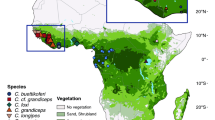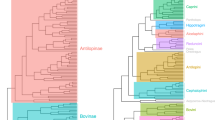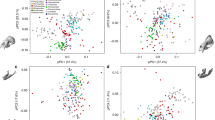Abstract
The diversifications of Darwin’s finches and Hawaiian honeycreepers are two text-book examples of adaptive radiation in birds. Why these two bird groups radiated while the remaining endemic birds in these two archipelagos exhibit relatively low diversity and disparity remains unexplained. Ecological factors have failed to provide a convincing answer to this phenomenon, and some intrinsic causes connected to craniofacial evolution have been hypothesized. The tight coevolution of the beak and the remainder of the skull in diurnal raptors and parrots suggests that integration may be the prevalent condition in landbirds (Inopinaves). This is in contrast with the archetypal relationship between beak shape and ecology in Darwin’s finches and Hawaiian honeycreepers, which suggests that the beak can adapt as a distinct module in these birds. Modularity has therefore been proposed to underpin the adaptive radiation of these groups, allowing the beak to evolve more rapidly and freely in response to ecological opportunity. Here, using geometric morphometrics and phylogenetic comparative methods in a broad sample of landbird skulls, we show that craniofacial evolution in Darwin’s finches and Hawaiian honeycreepers seems to be characterized by a tighter coevolution of the beak and the rest of the skull (cranial integration) than in most landbird lineages, with rapid and extreme morphological evolution of both skull regions along constrained directions of phenotypic space. These patterns are unique among landbirds, including other sympatric island radiations, and therefore counter previous hypotheses by showing that tighter cranial integration, not only modularity, can facilitate evolution along adaptive directions.
This is a preview of subscription content, access via your institution
Access options
Access Nature and 54 other Nature Portfolio journals
Get Nature+, our best-value online-access subscription
$29.99 / 30 days
cancel any time
Subscribe to this journal
Receive 12 digital issues and online access to articles
$119.00 per year
only $9.92 per issue
Buy this article
- Purchase on Springer Link
- Instant access to full article PDF
Prices may be subject to local taxes which are calculated during checkout




Similar content being viewed by others
Data availability
All relevant data are available via the University of Bristol’s DataBris repository at https://data.bris.ac.uk/data/dataset/3kpwgpnqewcy2tvak6uzzdztt.
References
Jetz, W., Thomas, G., Joy, J., Hartmann, K. & Mooers, A. The global diversity of birds in space and time. Nature 491, 444–448 (2012).
Cooney, C. R. et al. Mega-evolutionary dynamics of the adaptive radiation of birds. Nature 542, 344–347 (2017).
Burns, K. J., Hackett, S. J. & Klein, N. K. Phylogenetic relationships and morphological diversity in Darwin’s finches and their relatives. Evolution 56, 1240–1252 (2002).
Arbogast, B. S. et al. The origin and diversification of Galapagos mockingbirds. Evolution 60, 370–382 (2006).
Lovette, I. J., Bermingham, E. & Ricklefs, R. E. Clade-specific morphological diversification and adaptive radiation in Hawaiian songbirds. Proc. R. Soc. Lond. B 269, 37–42 (2002).
Pratt, H. D. & Conant, S. The Hawaiian Honeycreepers: Drepanidinae (Oxford Univ. Press, 2005).
Tokita, M., Yano, W., James, H. F. & Abzhanov, A. Cranial shape evolution in adaptive radiations of birds: comparative morphometrics of Darwin’s finches and Hawaiian honeycreepers. Phil. Trans. R. Soc. B 372, 20150481 (2017).
Darwin, C. The Zoology of the Voyage of HMS Beagle: Under the Command of Captain Fitzroy, RN, During the Years 1832 to 1836: Published with the Approval of the Lords Commissioners of Her Majesty’s Treasury (Smith, Elder and Company, 1839).
Mayr, E. The zoogeographic position of the Hawaiian Islands. Condor 45, 45–48 (1943).
Fleischer, R. C., James, H. F. & Olson, S. L. Convergent evolution of Hawaiian and Australo-Pacific honeyeaters from distant songbird ancestors. Curr. Biol. 18, 1927–1931 (2008).
Bright, J. A., Marugán-Lobón, J., Cobb, S. N. & Rayfield, E. J. The shapes of bird beaks are highly controlled by nondietary factors. Proc. Natl Acad. Sci.USA 113, 5352–5357 (2016).
Abzhanov, A. The old and new faces of morphology: the legacy of D’Arcy Thompson’s ‘theory of transformations’ and ‘laws of growth’. Development 144, 4284–4297 (2017).
Goswami, A., Smaers, J., Soligo, C. & Polly, P. The macroevolutionary consequences of phenotypic integration: from development to deep time. Phil. Trans. R. Soc. B 369, 20130254 (2014).
Klingenberg, C. P. Studying morphological integration and modularity at multiple levels: concepts and analysis. Phil. Trans. R. Soc. B 369, 20130249 (2014).
Felice, R. N., Randau, M. & Goswami, A. A fly in a tube: macroevolutionary expectations for integrated phenotypes. Evolution 72, 2580–2594 (2018).
Olson, E. C. & Miller, R. L. Morphological Integration (Univ. Chicago Press, 1999).
Villmoare, B. Morphological integration, evolutionary constraints, and extinction: a computer simulation-based study. Evol. Biol. 40, 76–83 (2013).
Fisher, R. A. The Genetic Theory of Natural Selection (Dover, 1958).
Kirschner, M. & Gerhart, J. Evolvability. Proc. Natl Acad. Sci. USA 95, 8420–8427 (1998).
Wagner, G. P. & Altenberg, L. Perspective: complex adaptations and the evolution of evolvability. Evolution 50, 967–976 (1996).
Raff, R. A. The Shape of Life: Genes, Development, and the Evolution of Animal Form (Univ. Chicago Press, 2012).
Wagner, G. Coevolution of functionally constrained characters: prerequisites for adaptive versatility. Biosystems 17, 51–55 (1984).
Marroig, G. & Cheverud, J. M. Size as a line of least evolutionary resistance: diet and adaptive morphological radiation in New World monkeys. Evolution 59, 1128–1142 (2005).
Hansen, T. F. Is modularity necessary for evolvability? Remarks on the relationship between pleiotropy and evolvability. Biosystems 69, 83–94 (2003).
Felice, R. N. & Goswami, A. Developmental origins of mosaic evolution in the avian cranium. Proc. Natl Acad. Sci. USA 115, 555–560 (2018).
Bright, J. A., Marugán-Lobón, J., Rayfield, E. J. & Cobb, S. N. The multifactorial nature of beak and skull shape evolution in parrots and cockatoos (Psittaciformes). BMC Evol. Biol. 19, 104 (2019).
Hackett, S. J. et al. A phylogenomic study of birds reveals their evolutionary history. Science 320, 1763–1768 (2008).
Jarvis, E. D. et al. Whole-genome analyses resolve early branches in the tree of life of modern birds. Science 346, 1320–1331 (2014).
Prum, R. O. et al. A comprehensive phylogeny of birds (Aves) using targeted next-generation DNA sequencing. Nature 526, 569–573 (2015).
Gibbs, H. L. & Grant, P. R. Oscillating selection on Darwin’s finches. Nature 327, 511–513 (1987).
Grant, P. R. & Grant, B. R. Evolution of character displacement in Darwin’s finches. Science 313, 224–226 (2006).
Smith, T. B., Freed, L. A., Lepson, J. K. & Carothers, J. H. Evolutionary consequences of extinctions in populations of a Hawaiian honeycreeper. Conserv. Biol. 9, 107–113 (1995).
Darwin, C. & Wallace, A. On the tendency of species to form varieties; and on the perpetuation of varieties and species by natural means of selection. Zool. J. Linn. Soc. 3, 45–62 (1858).
Klingenberg, C. P. Cranial integration and modularity: insights into evolution and development from morphometric data. Hystrix 24, 43–58 (2013).
Schluter, D. Adaptive radiation along genetic lines of least resistance. Evolution 50, 1766–1774 (1996).
Randau, M. & Goswami, A. Unravelling intravertebral integration, modularity and disparity in Felidae (Mammalia). Evol. Dev. 19, 85–95 (2017).
Losos, J. B. & Ricklefs, R. E. Adaptation and diversification on islands. Nature 457, 830–836 (2009).
Wright, N. A., Steadman, D. W. & Witt, C. C. Predictable evolution toward flightlessness in volant island birds. Proc. Natl Acad. Sci. USA 113, 4765–4770 (2016).
van der Geer, A. A., Lyras, G. A., Mitteroecker, P. & MacPhee, R. D. From Jumbo to Dumbo: cranial shape changes in elephants and hippos during phyletic dwarfing. Evol. Biol. 45, 303–317 (2018).
Grant, B. R. & Grant, P. R. Evolution of Darwin’s finches caused by a rare climatic event. Proc. R. Soc. Lond. B 251, 111–117 (1993).
Fritz, J. A. et al. Shared developmental programme strongly constrains beak shape diversity in songbirds. Nat. Commun. 5, 3700 (2014).
Yuri, T. et al. Parsimony and model-based analyses of indels in avian nuclear genes reveal congruent and incongruent phylogenetic signals. Biology 2, 419–444 (2013).
Del Hoyo, J. et al. Handbook of the Birds of the World Alive (Lynx Editions, 2017).
Rambaut, A. & Drummond, A. TreeAnnotator v1.7.0 (2013); http://beast.community/treeannotator.html
Rohlf, F. tpsDig v.2.10 (Department of Ecology and Evolution, State Univ. New York at Stony Brook, 2006).
Rohlf, F. tpsRelw, relative warps analysis (Department of Ecology and Evolution, State Univ. New York at Stony Brook, 2010).
Perez, S. I., Bernal, V. & Gonzalez, P. N. Differences between sliding semi-landmark methods in geometric morphometrics, with an application to human craniofacial and dental variation. J. Anat. 208, 769–784 (2006).
Torcida, S., Perez, S. I. & Gonzalez, P. N. An integrated approach for landmark-based resistant shape analysis in 3D. Evol. Biol. 41, 351–366 (2014).
Klingenberg, C. MorphoJ: an integrated software package for geometric morphometrics. Mol. Ecol. Resour. 11, 353–357 (2011).
R Core Team R: A Language and Environment for Statistical Computing (R Foundation for Statistical Computing, 2017); http://www.R-project.org/
Pagel, M. & Meade, A. BayesTraits v.2.0 (Univ. Reading, 2013).
Venditti, C., Meade, A. & Pagel, M. Multiple routes to mammalian diversity. Nature 479, 393–396 (2011).
Adams, D. C. & Collyer, M. L. Multivariate phylogenetic comparative methods: evaluations, comparisons, and recommendations. Syst. Biol. 67, 14–31 (2017).
Adams, D. C. & Felice, R. N. Assessing trait covariation and morphological integration on phylogenies using evolutionary covariance matrices. PLoS ONE 9, e94335 (2014).
Rohlf, F. J. & Corti, M. Use of two-block partial least-squares to study covariation in shape. Syst. Biol. 49, 740–753 (2000).
Rohlf, F. J. & Slice, D. Extensions of the Procrustes method for the optimal superimposition of landmarks. Syst. Biol. 39, 40–59 (1990).
Bookstein, F. L. in Advances in Morphometrics. NATO ASI Series (Series A: Life Sciences) Vol. 284 (eds Marcus, L. F. et al.) 131–151 (Springer, 1996).
Dryden, I. & Mardia, K. Statistical Analysis of Shape (Wiley, 1998).
Siegel, A. F. & Benson, R. H. A robust comparison of biological shapes. Biometrics 38, 341–350 (1982).
Cardini, A. Integration and modularity in Procrustes shape data: is there a risk of spurious results? Evol. Biol. 46, 90–105 (2018).
Chapman, R. E. Conventional procrustes approaches. In Proc. of the Michigan Morphometrics Workshop Vol. 2 (eds Rohlf, F. J. & Bookstein, F.) 251–267 (Univ. Michigan Museum of Zoology, 1990).
Zelditch, M. L., Swiderski, D. L. & Sheets, H. D. Geometric Morphometrics for Biologists: A Primer (Academic, 2012).
Klingenberg, C. P. & McIntyre, G. S. Geometric morphometrics of developmental instability: analyzing patterns of fluctuating asymmetry with Procrustes methods. Evolution 52, 1363–1375 (1998).
Bookstein, F. L. in Image Fusion and Shape Variability Techniques: Proceedings (eds Gill, C. A. & Mardia, K. V.) 59–70 (Leeds University Press, 1996).
Adams, D. C., Rohlf, F. J. & Slice, D. E. A field comes of age: geometric morphometrics in the 21st century. Hystrix 24, 7–14 (2013).
Adams, D. C., Rohlf, F. J. & Slice, D. E. Geometric morphometrics: ten years of progress following the ‘revolution’. Ital. J. Zool. 71, 5–16 (2004).
Adams, D. C., Collyer, M. L. & Kaliontzopoulou, A. Geomorph: software for geometric morphometric analyses. R package version 3.0.7 (2018); https://cran.r-project.org/package=geomorph
Zelditch, M. L., Ye, J., Mitchell, J. S. & Swiderski, D. L. Rare ecomorphological convergence on a complex adaptive landscape: body size and diet mediate evolution of jaw shape in squirrels (Sciuridae). Evolution 71, 633–649 (2017).
Uyeda, J. C., Caetano, D. S. & Pennell, M. W. Comparative analysis of principal components can be misleading. Syst. Biol. 64, 677–689 (2015).
Chira, A. M. & Thomas, G. H. The impact of rate heterogeneity on inference of phylogenetic models of trait evolution. J. Evol. Biol. 29, 2502–2518 (2016).
Monteiro, L. R. Morphometrics and the comparative method: studying the evolution of biological shape. Hystrix 24, 25–32 (2013).
Adams, D. C. & Collyer, M. L. On the comparison of the strength of morphological integration across morphometric datasets. Evolution 70, 2623–2631 (2016).
Mitteroecker, P. & Bookstein, F. The conceptual and statistical relationship between modularity and morphological integration. Syst. Biol. 56, 818–836 (2007).
Marroig, G., Shirai, L. T., Porto, A., de Oliveira, F. B. & De Conto, V. The evolution of modularity in the mammalian skull II: evolutionary consequences. Evol. Biol. 36, 136–148 (2009).
Renaud, S., Auffray, J. C. & Michaux, J. Conserved phenotypic variation patterns, evolution along lines of least resistance, and departure due to selection in fossil rodents. Evolution 60, 1701–1717 (2006).
Acknowledgements
We thank J. Cooper and J. White (NHM Tring), and C. M. Milensky and B. K. Schmidt (Smithsonian National Museum of Natural History) for access to specimens. We thank F. Blanco, M. Fabbri, I. Menéndez and L. Porras for discussions on the evolutionary implications of this research. We thank G. Thomas, T. Püschel, C. Klingenberg, A. Elsler, F. Babarović and S. de Esteban-Trivigno for insight and discussion on the methods. We thank Ó. Sanisidro and L. Balsa Pascual for design and technical advice that greatly improved the quality of the graphic support. G.N. was supported by a PG Scholarship/Studentship from the Alumni Foundation, University of Bristol, UK, and is currently supported by the ERC project ‘TEMPO’ (grant number 639791). J.M.-L. is supported by the Spanish MINECO, Project CGL-2013-42643. E.J.R. and J.A.B. were supported by BBSRC grant number BB/I011668/1. C.R.C. is supported by a Leverhulme Early Career Fellowship (grant number ECF-2018-101).
Author information
Authors and Affiliations
Contributions
The focus and design of this research were developed by G.N., J.M.-L., J.A.B. and E.R.J. C.R.C. conducted the VRMAs. G.N. conducted the remaining analyses. G.N., J.M.-L., J.A.B., C.R.C. and E.R.J. wrote the manuscript.
Corresponding authors
Ethics declarations
Competing interests
The authors declare no competing interests.
Additional information
Publisher’s note Springer Nature remains neutral with regard to jurisdictional claims in published maps and institutional affiliations.
Extended data
Extended Data Fig. 1 Landmarks and semilandmarks used in this study for the beak (white) and skull (black) blocks.
Landmark definition in Extended Data Table 1.
Extended Data Fig. 2
Landmarks used in this study. **Cracraft, J. The lacrimal-ectethmoid bone complex in birds: a single character analysis. American Midland Naturalist, 316-359 (1969).
Extended Data Fig. 3 Tempo and mode of craniofacial shape evolution in landbirds (labelled by major radiations).
Phylomorphospaces of the first three PCs (a) and rates of evolution (b) for the whole skull configurations. Dot colours in phylomorphospaces (a) correspond to each major landbird lineage (colour legend by each silhouette in B). Branch colours in B indicate relative rate of shape evolution. Inferred rate shifts with higher posterior probability than 0.7 are plotted in corresponding branches (circles) or nodes (triangles) in the phylogeny in B. Posterior probability of each inferred rate shift is indicated by size as indicated in the legend in b.
Extended Data Fig. 4 Tempo and mode of beak shape evolution in landbirds (labelled by major radiations).
Phylomorphospaces of the first three PCs (a) and rates of evolution (b) for the beak block configurations. Colours and legends as before.
Extended Data Fig. 5 Tempo and mode of skull shape evolution in landbirds (labelled by major radiations).
Phylomorphospaces of the first three PCs (a) and rates of evolution (b) for the skull block configurations. Colours and legends as before.
Extended Data Fig. 6 Shape differences associated with the first pair of PLS vectors (PLS1) for the beak block and the skull block for the main lineages of passerines.
Polar histograms summarizing angle comparisons between the PLS1 vectors for the beak (b) and skull (c) blocks. As orientation of PLS1 vectors is arbitrary, the maximum possible angle between PLS1 vectors is 90°. * indicates single angular comparison of the PLS1 vectors of Passeroidea excluding DF and HH.
Extended Data Fig. 7 Extreme morphologies and spread along lines of least resistance for each family within the parvorder Passeroidea in our sample.
Within-family maximum Procrustes distances for PLS1scores (situation 2) for both beak and skull blocks. Done for all the families that include two or more species in our sample. Legend for labels in Extended Data Table 2. Dot colours correspond to the ages of the most common recent ancestor (MRCA) for each of the focal families in our MCC tree.
Extended Data Fig. 8 Relationship between levels of cranial integration and evolutionary rates per clade.
Dotplot showing the relationship between mean and median log-rate per landbird/passerine clade (clades as defined in Figs. 3, 4 and Table 1) with mean clade zscore values (that is evolutionary covariation, situation 2). Dashed ellipses encompass the values for selected clades: 1, All landbirds; 2, Non-passerines; 3, Passeriformes; 4, Passeri; 5, Tyranni; 6, Psittaciformes; P.1, Passeroidea (including Darwin’s finches and Hawaiian honeycreepers); P.2. Passeroidea (excluding Darwin’s finches and Hawaiian honeycreepers).
Extended Data Fig. 10 Comparisons of the pattern of maximum covariation lines between Passeroidea and other selected passerine clades.
Angles (θ, degrees) for each pair of PLS1 vectors for the beak and skull block in situation 2 between Passeroidea (including and excluding DF and HH), Muscicapida (the parvorder that includes the passerine radiations sympatric to DF and HH) and Passeriformes, Passeri (all oscine passerines) and Tyranni (all suboscine passerines). As orientation of PLS1 vectors is arbitrary, the maximum possible angle between PLS1 vectors is 90°. * excluding DF and HH.
Supplementary information
Supplementary Information
Extended results, Supplementary Figs. 1–6, Tables 1–3 and references.
Supplementary Data
Supplementary Data Tables 1–5.
Rights and permissions
About this article
Cite this article
Navalón, G., Marugán-Lobón, J., Bright, J.A. et al. The consequences of craniofacial integration for the adaptive radiations of Darwin’s finches and Hawaiian honeycreepers. Nat Ecol Evol 4, 270–278 (2020). https://doi.org/10.1038/s41559-019-1092-y
Received:
Accepted:
Published:
Issue Date:
DOI: https://doi.org/10.1038/s41559-019-1092-y
This article is cited by
-
Rapid evolutionary change in trait correlations of single proteins
Nature Communications (2024)
-
Dynamic evolutionary interplay between ontogenetic skull patterning and whole-head integration
Nature Ecology & Evolution (2024)
-
Detecting natural selection in trait-trait coevolution
BMC Ecology and Evolution (2023)
-
Bird clades with less complex appendicular skeletons tend to have higher species richness
Nature Communications (2023)
-
Environmental signal in the evolutionary diversification of bird skeletons
Nature (2022)



